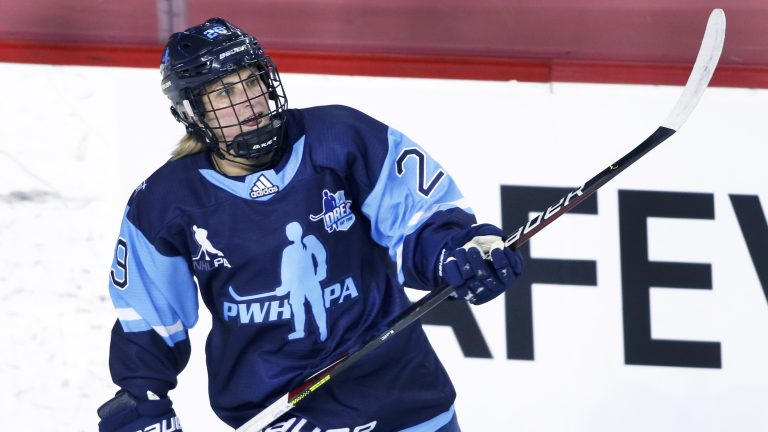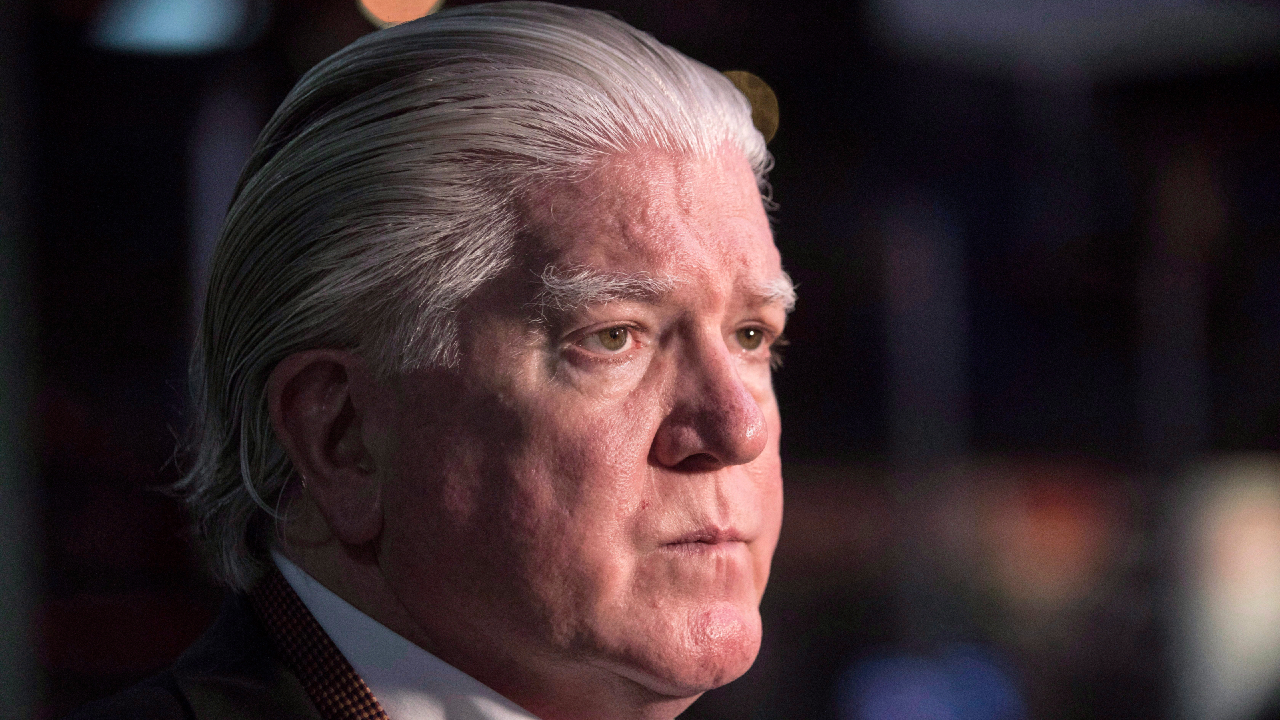The Professional Women’s Hockey League is set to hit the ice in January, and on Tuesday we got a glimpse of what it will look like.
During a virtual press conference, PWHL board member Stan Kasten and senior vice-preisdent of hockey operations Jayna Hefford shed light on how the league is coming together — including team locations, draft and free agency details, key dates on the calendar and details still being ironed out before launch.
Here’s a recap of what we learned, and what we expect to find out soon about this new women’s league:
PWHL UNVEILS ORIGINAL SIX FRANCHISE LOCATIONS
As announced in June, the new league will be composed of six franchises: Three in Canada and three in the United States. While we don’t yet know franchise nicknames or logos, we do know the markets.
Toronto: This hockey hotbed has been home to other women’s pro teams in the past, including the CWHL’s Toronto Furies and more recently the PHF’s reigning champs, the Toronto Six. Many of the game’s elite players hail from the GTA, and there will no doubt be a built-in fanbase from Day 1.
Ottawa: It’s not just about location, though that’s ideal when we’re talking about establishing rivalries — the Battle of Ontario is alive and well in the NHL, and Ottawa’s proximity to Montreal should make for fun crowds. Canada’s capital has never had a professional women’s hockey team, but Kasten was quick to praise Ottawa for its enthusiasm, passion and facilities.
Montreal: Hefford called it a “no-brainer” to have a franchise in Montreal. Previously home to a CWHL and, later, a PHF team, the city was never in doubt as a PWHL market. (Captain Canada Marie-Philip Poulin is no doubt already the face of this franchise, right?)
Minneapolis-St. Paul: “Minnesota was always a priority market for us,” said Hefford. The region is known for both its homegrown talent and as a destination for so many of the best college players in the game. Minnesota had a PHF team and was also a hub for the PWHPA. While this squad will likely need to put in a few more miles than the other five markets nestled in the Northeast, Kasten was not concerned.
New York City area: The question here is where, exactly, in (or outside of) New York this team will be. Kasten couldn’t specify whether it would be New York City proper, and also said New Jersey and Connecticut are in the fold as home-ice options.
Boston: Another no-brainer in terms of a built-in following and history of success both in hockey and the greater pro sports world overall. The PHF’s Boston Pride were always considered the class of the league, and had the fanbase to back that up.
Although all of these markets have several options for their team’s “home ice,” Tuesday’s press conference didn’t reveal any specifics there. Kasten said it’s very likely that home games could be played in a variety of locations, both within and outside of these markets in the first season — think neutral-site games, special events and possible venue partnerships with OHL, AHL and NHL teams in those markets.
KEY DATES: DRAFT, FREE AGENCY, TRAINING CAMPS
Friday, Sept. 1: Free agency opens
During this 10-day window, each franchise can officially sign three players to standard player agreements. These veteran players will form the foundations of each club, and as a result will not be part of the draft. Players currently in the NCAA or those graduating from U Sports programs are not eligible to sign with a team during this period. The deadline for this initial free agency window is Sept. 10.
Sunday, Sept. 3: Deadline for prospective players to declare for PWHL draft
Hefford outlined the league’s efforts, via a nine-member player evaluation committee, to identify a pool of more than 300 of the most talented players around the world. What happens next is up to the players, who were informed Monday night of the league’s operations and timelines. Players who wish to declare themselves eligible to be drafted to one of the PWHL’s six teams must do so by Sept. 3. Players do not have to have been included on the initial 300-plus list of names to seek eligibility.
Sunday, Sept. 10: End of initial free agency period
By this time, each franchise will have signed three core players, with the focus then turning to the draft to fill out the rest of the training camp roster.
Monday, Sept. 18: PWHL Draft
The first-ever PWHL player draft will take place in Toronto on Sept. 18. The draft will run 15 rounds deep. Draft order will be determined by a lottery, and will follow a snake-draft format (the team picking last in Round 1 will select first in Round 2).
By the end of draft day, teams will each have 18 players — three pre-draft free agent signings and 15 draftees. All undrafted players will become free agents immediately after the draft and can thus sign a standard player agreement with any team.
Training camp rosters, which each must have a minimum of 28 players, will be fleshed out through this second free agency period and via negotiated tryouts.
After a team drafts a player, that team holds the player’s signing rights for two years. If a contract is not signed during that time, the player can become eligible again to be drafted. A player can declare for a maximum of two drafts.
Week of Nov. 13: Training camps open, teams finalize rosters
As outlined by Hefford, each team must bring at least 28 players to training camp, and cannot have more than 20 players signed before camp opens.
The timing of these camps means franchises will have about six weeks between the first strides at practice and the start of the 2023-24 regular season, which is set to begin in January. (No date was specified.)
By the end of training camp, each team must cut its roster to 23 players.
As negotiated in the CBA, which was ratified earlier this summer, player contracts will be valued between $35,000 and $80,000 annually. While the majority of contracts will feature one- or two-year terms, each franchise is required to sign six players to three-year deals valued at $80,000 each.
January 2024: Inaugural PWHL season begins
Kasten was not able to specify a date for puck drop on the PWHL, but he indicated January 2024 — and that very likely means the early days of the new year as opposed to the end of the month — remains the target for the start of play.
A full schedule is expected to be released sometime in October.
LEAGUE OPERATIONS: FRANCHISES, TIMELINES, HIRINGS
Franchises’ general managers to be named in the coming days
Kasten and Hefford didn't name the individuals who will be leading the original six franchises and building each roster from the ground up, but indicated that information is coming — and soon.
Hefford said the league is “in the final stages” of the hiring process, an intensive period that began more than a month ago, and will making those announcements “very shortly.” She said she’s been encouraged by the quality of candidates who bring a variety of experiences and backgrounds to the table.
Once general manager hirings are made official, they’ll have to hit the ground running — free agency opens Friday, after all, with GMs eligible to sign their franchise cornerstones.
2023-24 PWHL season will be 24 games, but will quickly expand
Starting in January, each of the PWHL’s six teams will play 24 regular-season games, after which will be the playoffs.
Schedules will quickly be expanded from 24 games to 32 for the 2024-25 season, which will set the precedent for future campaigns. Beginning in 2024-25, the PWHL is schedule expected to open each November and run through to May, followed by playoffs.
Yes, there’s a trophy up for grabs (but no, we don’t know details yet)
Kasten said trophy details — such as a name and what that hardware might look like — aren’t ready to be released. The Premier Hockey Federation’s trophy was called the Isobel Cup. In the CWHL, it was known as the Clarkson Cup.
Like team names and designs, league logo still in the works
Although the league has ironed out many operational details, the designs are still to come. That includes the league logo itself.
Kasten said team names and team and league logos will be revealed in the coming weeks.
International play remains a priority
International tournaments, such as the Olympic Games and the world championship, have been instrumental in growing the women’s game, and Kasten indicated with enthusiasm that the league’s presence won’t change that. He told reporters the international calendar will remain a priority, though did not provide details on how IIHF schedules might affect PWHL seasons during Olympic and world championship years.
Brian Burke named executive director of the PWHL players’ association
Long-time NHL executive Brian Burke, who most recently was part of the Pittsburgh Penguins front office, will lead the players’ union. Burke, who served on the board of the now-defunct Canadian Women’s Hockey League before it shuttered in 2019 (coinciding with the establishment of the PWHPA), called Tuesday “the most exciting day in the history of women’s hockey.”
He spoke briefly about the league’s core values, and made it clear the league is looking forward, not back.
"We are committed to a platform of fairness and equity and equality. And the core values that started this league will not ever change," Burke said. "We don't care where you played before you got here. We're excited to have you here — if you can play here, you can play."
PWHL making progress on transgender policy
The league was not able to share details on Tuesday, but Hefford said that a transgender policy is in the works and will be revealed when complete.
NHL has been “fantastically supportive” of PWHL
Kasten spoke highly of his many conversations with NHL executives, including commissioner Gary Bettman, and said the professional men’s league has been a great resource when it comes to consulting for advice. It’s likely we’ll see collaboration on marquee events, as well as neutral-site games hosted in NHL rinks.
Broadcast, streaming plans still be sorted
Asked about the league’s broadcast and streaming access, Kasten said that’s still being worked on. He specified that the goal is to have all games available at least via an online stream.
No head office hub (yet)
Right now, league leadership is scattered across Canada and the United States, working remotely to bring this league together. Kasten indicated Toronto could be a hub for a head office should the league choose to create one, but said that is not a Year 1 priority.
HOW WE GOT HERE
Earlier this summer, the landscape of women’s professional hockey was forever altered with news that the Mark Walter Group, partner of Billie Jean Enterprises and the Professional Women’s Hockey Players Association, had bought out the Premier Hockey Federation. The move saw the PHF and all seven of its franchises dissolved, along with the immediate voiding of all players’ contracts, to make way for a new North American league that aligned with the PWHPA’s vision.
That vision, born in 2019 when more than 100 of the game’s top female players — including the majority of Canadian and American national team members — formed the PWHPA after the closure of the Canadian Women’s Hockey League, was of one singular, sustainable destination for the best women’s players in the world.







